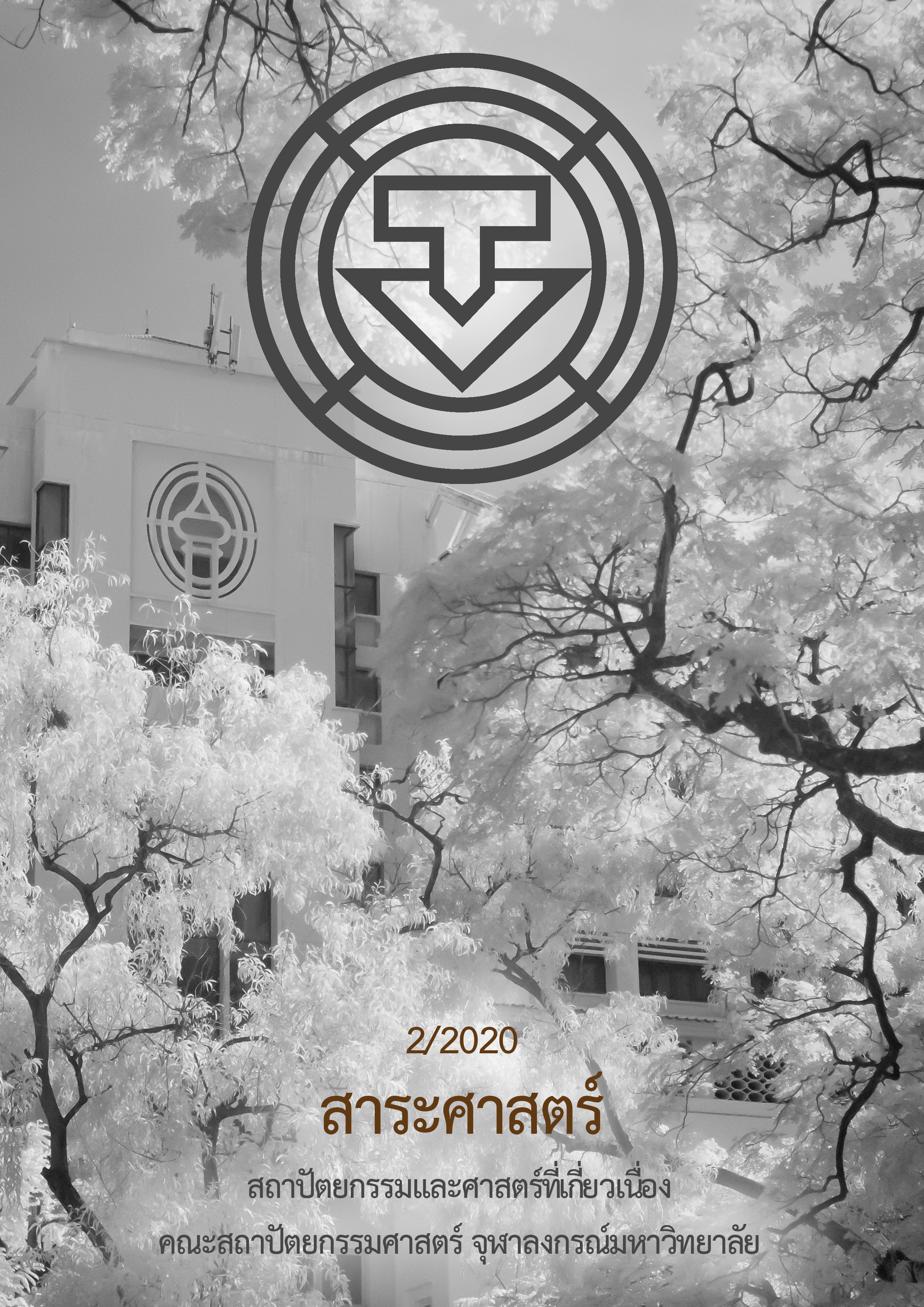Potential Architectural Development for The Well-Being of Condominium Residents in Bangkok : Case Studies of The Room Sukhumvit 69 and The Room Sathorn-Pan Road
Main Article Content
Abstract
Currently there has been a constant increase in the development of vertical residential buildings within Bangkok area due to growing urban population and an increasing demand for residency within the inner Bangkok area. Due to the limitation of space availability within the area along with the shift in consumer housing preferences to condominium, property developers are inclined to develop vertical residential buildings namely, condominium. An interesting research regarding the impact of living in a high rise residence in South Korea has revealed that residents living in a building at the 18th floor or above are more likely to have an anxiety and higher blood pressure especially in elder and infant. Residents are more stressful with noises, the usage of elevator and also expresses higher concern with security and potential accidents. However, residents were highly satisfied with the convenience provided comparing to other residency alternatives hence, this has been the reason for this research study to uncover the key influential factors on condominium residents well-being in order to further provide a guideline for condominium development that promotes residents well-being. This research study will focus on studying the residents along with bringing in the concept ideas of the experts within the field through questionnaire and one on one in-depth interview. The studies will take place at The Room Sukhumvit69 and The Room Sathorn-Pan Road.
This research study has revealed that security, in terms of living and assets, has been the most important factor that affects residents well-being. Second to that are 4 factors all related to property management. When considering the factors that affect residents well-being internally, physical factors of the condominium project itself are indifferent with the perception of the residents. On the other hand, there is a difference between the physical factors of the condominium project and property management factors due to the difference within the height of the building. With residents residing in a building on 3 levels comprising of floor 1-8, floor 9-24, and floor 25 or above having indifferent level of well-being with a significant level of 0.05.
Majority of the experts agreed that societal factors are highly influential on the well-being of the residents which is directly associated with property management factors. Whereas, positive physical factors facilitate property management which consequently promotes the well-being of the resident accompanying with a positive interaction among the residents living within the residence itself.
Article Details
References
ณิชารัตน์ อัครมณี. “โอกาสและข้อจำกัดของการพัฒนาโครงการคอนโดมิเนียมโดยใช้แนวคิดสุขภาวะของผู้ประกอบการในเขตกรุงเทพมหานคร.” วิทยานิพนธ์ปริญญามหาบัณฑิต ภาควิชาเคหการ คณะสถาปัตยกรรมศาสตร์ จุฬาลงกรณ์มหาวิทยาลัย, 2561.
ดวงกมล ศักดิ์เลิศสกุล. “สุขภาพแบบองค์รวม (Holistic Health).” สืบค้น 22 พฤศจิกายน 2562. https://bit.ly/2JOmKjZ.
Thinkofliving. “ประเภท Segment ของคอนโดมิเนียมและบ้านแนวราบ กับการรีวิวเจาะลึก.” สืบค้น 9 ตุลาคม 2562. https://bit.ly/39QFt92.
ประเวช ตันติพิวัฒนสกุล. “สุขภาวะคนเมืองเรื่องที่คนเมืองควรรู้.” สำนักข่าวสร้างสุข (17 สิงหาคม 2560). สืบค้น 8 ธันวาคม 2562. https://bit.ly/2VcDpD7.
พิมลพรรณ อิศรภักดี. “ลักษณะครอบครัวไทยเปลี่ยนไปอย่างไรในกว่า 20 ปีที่ผ่านมา.” ประชากรและการพัฒนาสถาบันวิจัยและสังคมมหิดล. 37(เมษายน 2560) : 6-7.
ภาวดี ธุววงศ์. “การพัฒนาเกณฑ์การออกแบบอาคารเขียวเพื่อส่งเสริมสุขภาวะสำหรับอาคารที่พักอาศัยแบบยั่งยืนในประเทศไทย.” วิทยานิพนธ์ปริญญามหาบัณฑิต คณะสถาปัตยกรรมศาสตร์ จุฬาลงกรณ์มหาวิทยาลัย, 2559.
วิกิง, ไมก์. ลุกกะ: วิถีความสุขจากทุกมุมโลก. พิมพ์ครั้งที่ 1. แปลโดย ลลิตา ผลผลา. กรุงเทพฯ: สำนักพิมพ์Bookscape, 2561.
วิริญจ์ วชิรปรัชญา. “แนวทางการพัฒนาโครงการของผู้ประกอบการกับการใช้งานของผู้พักอาศัยในอาคารชุดพักอาศัยใกล้สถานีรถไฟฟ้าบีทีเอส: กรณีศึกษา สถานีอ่อนนุช สถานีอารีย์ และสถานีกรุงธนบุรี.” วิทยานิพนธ์ปริญญามหาบัณฑิต ภาควิชาเคหการ คณะสถาปัตยกรรมศาสตร์ จุฬาลงกรณ์มหาวิทยาลัย, 2557.
ศูนย์ศึกษาความอยู่สบายของที่อยู่อาศัยและชุมชน. โครงการศึกษา มาตรฐานความอยู่สบายของที่อยู่อาศัยและชุมชนเพื่อการวางแผนพัฒนาที่อยู่อาศัยโดยกระบวนการมีส่วนร่วม. กรุงเทพฯ: จุฬาลงกรณ์มหาวิทยาลัย, 2560.
สุปรีดา อดุลยานนท์. “สุขภาวะทางปัญญาและใจ คือต้นทางมีสุขภาพกายดียั่งยืน.” หนังสือพิมพ์บ้านเมือง. สืบค้น 23 ธันวาคม 2562. https://bit.ly/2Vj6QmQ.
อัจศรา ประเสริฐสิน, ทัชชา สุริโยและปพน ณัฐเมธาวิน. “สุขภาวะของผู้สูงอายุ: แนวคิดและปัจจัยที่เกี่ยวข้อง.” วารสารสุขศึกษา 41, 1(มกราคม - มิถุนายน 2561): 1-15.
Diener, Ed. “Subjective Well-Being.” Psychological Bulletin 95, 3 (1984): 542-563.
Hoeger, W.W.K. and S.A., Hoeger. Lifetime Physical Fitness and Wellness. 8th ed. Belmont, CA.: Quebecor World, 2005.
Jaehyuk Lee, Je, Haeseong and Byun, Jeongsao. “Well-Being Index of Supertall Residential Building in Korea.” Building and Environment 46 (2011): 1184-1194.
Steemers, K. “Architecture for Wellbeing and Health.” Daylight and Architecture 23 (2015): 9-12.
Steemers, K. Healthy Homes: Designing with Light and Air for Sustainability and Wellbeing. London: RIBA, 2019.
The World Health Organization. “Five Well-Being Index (WHO-5).” Accessed September 22, 2019.
https://www.psykiatri-regionh.dk/who-5/Documents/WHO-5_Thai_revised.pdf.


